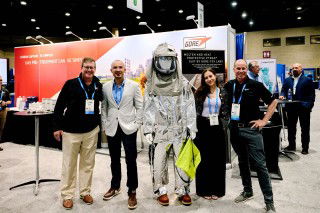Cemtech Europe 2019 was held at the InterContinental Hotel in Berlin, Germany, on 30 September-2 October. The conference agenda explored issues around the tightening of environmental legislation worldwide, including the EU Emissions Trading System (ETS), and the ways in which this is impacting on the European cement industry, driving new technologies and product development.

Cemtech Europe welcomed over 200 delegates to Berlin, Germany, in October
Opening the conference, Thomas Armstrong, managing director of International Cement Review, welcomed delegates to Berlin, just ahead of Unity Day, which commemorates the German reunification of 1990. He outlined the sustainability themes to be addressed in the programme, while also introducing a keynote presentation by Martin Schneider, CEO of VDZ (Germany).
Sustainability focus
Martin Schneider began his presentation by providing an overview of the supply-demand dynamics and technological developments taking place in the German cement industry. Regarding the country’s future, he noted that “these are historical days” and “that production is still expected to grow further”. Following 29Mt of consumption in 2019, VDZ forecasts “stable consumption for the years to come”.
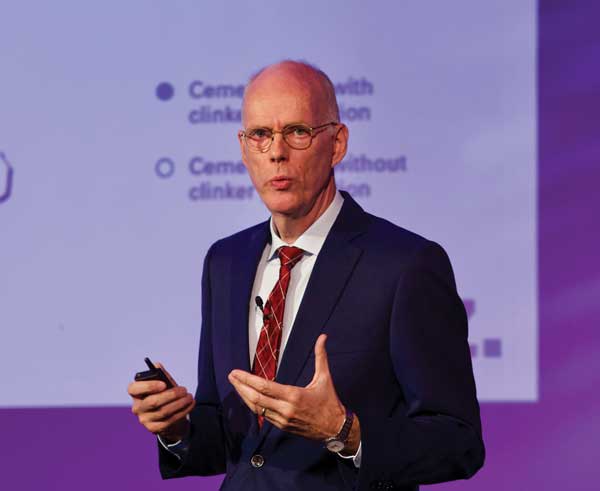
Martin Schneider, CEO of VDZ, delivered
a keynote presentation at the event
Moving on to consider the sustainability of the industry, Mr Schneider stated that the Paris Agreement “requires dramatic measures in all sectors and in our own”. Considering another angle, he also recognised that Germany’s plans to phase out coal and fossil fuel power plants by 2038 will have a knock-on effect on the availability of supplementary materials such as fly ash and lignite.
Looking down the line, Mr Schneider also noted that the cement industry requires the support of legislation and end-users to meet sustainability targets. “Targets for clinker efficiency are very ambitious, but we need good support, it can’t be the cement industry alone.” “If we come up with clinker-efficient cements, we must make sure they are bought”. Concluding, Mr Schneider added that: “at the end, as an industry we will have a bright future.”
Taking a wider scope, Koen Coppenholle, CEO of cembureau, the European cement association, provided a political context for the industry by looking at the European Commission’s goal for the EU to become the world’s first climate-neutral region by 2050, with this expected to be enshrined in law. Mr Coppenholle also considered the solutions the cement industry can offer along its value chain to reduce emissions.
Echoing Martin Schneider’s comments, Mr Coppenholle highlighted the importance of joint partnerships across the sector and beyond to meet the ambitious targets set by the European Commission. For example, he noted that: “further uptake of alternative fuels doesn’t depend on technology, it depends on regulation.” Set in 2013, the goals of cembureau are to see a 32 per cent reduction in CO2 emissions from the cement industries of its member countries by 2050. Currently, they have reached a 14 per cent reduction and therefore, are on track to meet the goal.
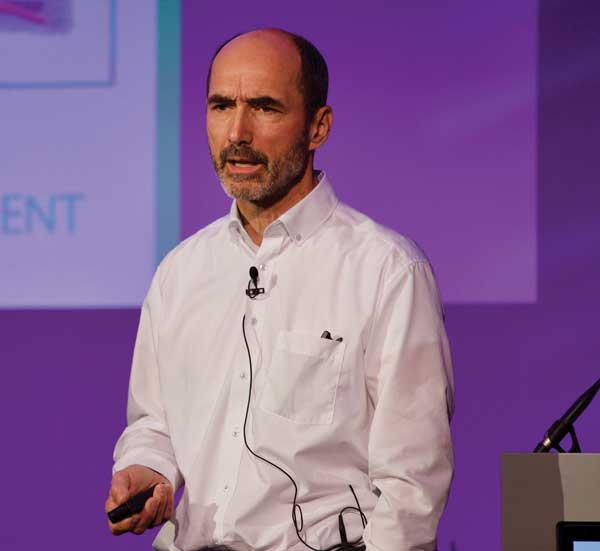
Peter Lukas, Group Director of Global Environmental
Sustainability at HeidelbergCement
Peter Lukas, Group Director of Global Environmental Sustainability at HeidelbergCement (Germany), outlined the company’s climate protection strategy and Vision 2050. Since the producer has a goal to achieve carbon neutrality by 2050, Mr Lukas looked at the necessary conditions, both technological and regulatory, which will enable deep decarbonisation. For example, opening its LEILAC technology pilot plant for process-integrated carbon capture.
However, as other speakers across the programme also referenced, current political and market frameworks require adjustment to support projects that seek to improve carbon capture technology and also create markets with revised expectations of product norms.
Peter Hoddinott, Independent Consultant (UK), discussed the implications of the EU Emissions Trading Scheme (EU-ETS) and Carbon Border Tax on the European cement industry, with probable outcomes of the former including higher cement prices and the increase in profitability of clinker import/grinding operations.
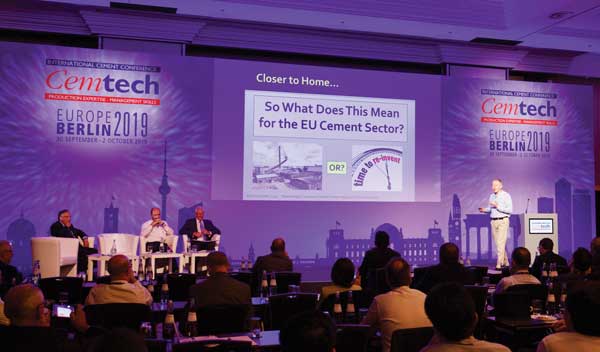
Presentations at Cemtech Europe 2019 had a focus on the regional cement sector
Manufacturing technology
As the programme progressed, presentations moved from large-scale regional market reports towards detailing the manufacturing technology which can help provide the changes required to improve the sustainability of cement production.
As such, project consultant Jan Baeyens illuminated the technological processes behind the SOLPART project, which aims to deliver a solar reactor suitable for cement raw meal calcination. The plans include simulating a 24/7 industrial process, which could reduce CO2 emissions by 40 per cent in the cement and lime industry.
Germany’s Georg Locher presented thyssenkrupp’s vision that improving the sustainability of the cement production process is based around five key areas: emissions, resources, smart technology, energy and binders. As such, the company’s solutions, as part of its larger Grey2Green project, include polysius® carbon neutrality and NOx reduction (emissions), fuel substitution (resources) and activated clay (binders).
Another presentation by VDZ, delivered by Marco Lindemann Lino, considered how flame thermography can be used to optimise the burning conditions of alternative fuels (for a full report on this, see ICR November, p82).
Digitalisation and Industry 4.0
Elsewhere, Laurent Seyler and Daniel Reiser, LafargeHolcim (Switzerland/Germany), explored the company’s ‘Plants of Tomorrow Initiative’, which targets a global network of over 270 integrated cement plants and grinding stations across more than 50 countries. For more information on this presentation, turn to the Technical Forum on p53. This month, the forum considers presentations delivered at Cemtech Europe 2019 under the digital transformation theme, including those given by Petuum/Cemex, McKinsey, kima, alcemy and inform.
Under the same theme, Christina Lund Jakobsen of CemWise (Denmark) looked at how weekly operational data reports can be used to improve the efficiency of cement plants. The reports include five signals that can help predict future problems in a cement plant before they occur, therefore, reducing the risk on unscheduled downtime.
Extended programme
The event concluded with the Gala Dinner and ICR Awards Ceremony, giving delegates a final opportunity to network with new connections and celebrate the conclusion of a successful event with live entertainment and a menu of delicious regional food.
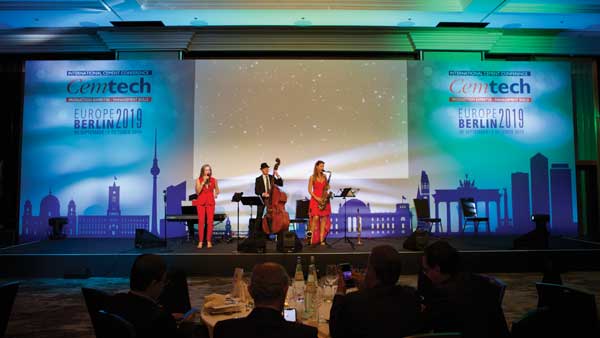
The Gala Dinner concluded the event with a variety of entertainment
Next event
Cemtech Middle East & Africa conference and exhibition will be held at the Grand Hyatt in Dubai, UAE, on 16-19 February 2020. For information, please visit: www.Cemtech.com/MEA2020
This article was first published in International Cement Review in December 2019.
